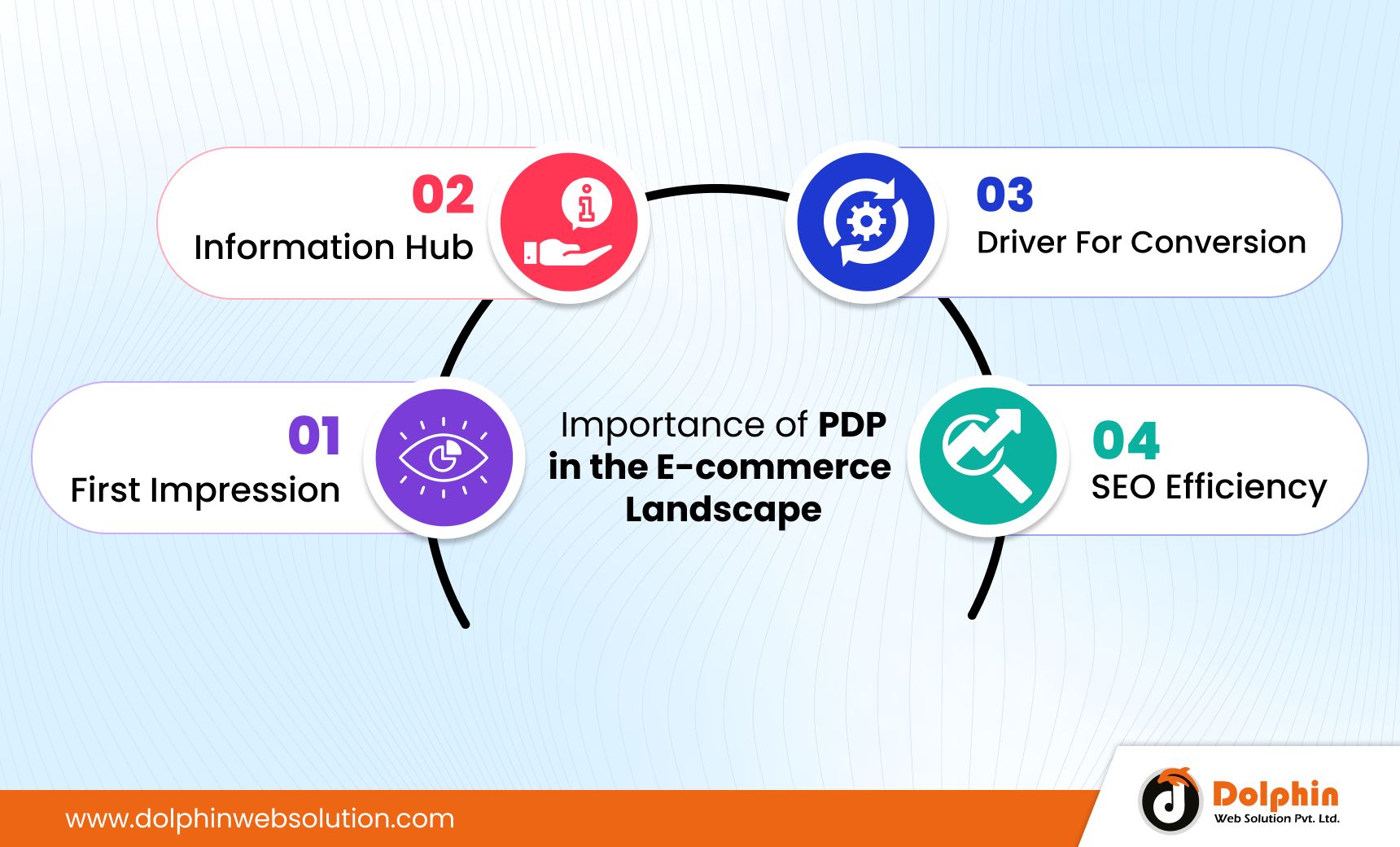What is PDP in E-commerce: Understanding the Product Detail Page

Table of Contents
Summary :
This article reveals the core of Product Detail Pages (PDP), which play a crucial role in e-commerce. It breaks down the components of an efficient PDP and emphasizes its importance for attracting consumers. By unraveling their complexities, readers better understand PDPs' influence on online buying experiences.
Introduction to PDP in E-commerce

In digital commerce, the success of potential sales depends on the effectiveness of the product description pages. Customers can use them to acquire a clear product picture and make buying decisions. Customers cannot be persuaded that your product is not worth their money by a product page that needs to be better designed and efficient. Because of this, when going for eCommerce development investing time and effort into product detail pages that convert well is essential. You’ve come to the correct place if you’re a new merchant searching for a thorough overview of the PDP eCommerce product description page. However, if you’ve been selling online for some time and want to learn how to optimize your PDP product page, read this post once. You’ll be able to frighten up anything valuable for yours.
An online store displays size, color, price, delivery, reviews, and other information on a single item’s product description page (PDP). It contains a picture and an “add to cart” button.
Importance of PDP in the E-commerce Landscape

1. First Impression
With the advent of Product Detail Pages (PDPs), “First Impression” in e-commerce assumes a new dimension. These pages serve as the online counterpart of a shop window, giving potential consumers their initial impressions of a product. A well-designed and aesthetically attractive PDP has the power to have an effect both now and in the future. A fascinating PDP may lure online buyers farther into the shopping experience, just as an enticing window display might draw passersby into a real store. A tidy layout, meaningful text, and high-quality photographs play important roles in establishing this first impression.
A good first impression emphasizes value, reliability, relevance, and beauty. A carefully crafted PDP highlights the product’s benefits and conveys the brand’s identity and dedication to excellence. This favorable view is influenced by consistent branding, clear product information, and user-friendly navigation. A visually appealing PDP establishes the tone for the customer’s journey, deciding whether they will browse further, add more goods to their basket, and ultimately finish the transaction. The first impression made by a PDP, which serves as the entrance to a bigger shopping experience, may greatly affect the user’s course and the way they view the company and its offerings.
2. Information Hub
Product Detail Pages (PDPs) function as thorough “Information Hubs” that hold various product-related information in the complex world of e-commerce. These sections examine the product’s characteristics, features, advantages, and more beyond simple descriptions and pictures. PDPs equip potential consumers with the knowledge they need to make educated purchase decisions by gathering this extensive information in one location.
To bridge the gap between the online shopping experience and the tactile exploration of real objects, PDPs play a crucial role as information centers. They give buyers a virtual way to examine, analyze, and comprehend the specifics of the product before committing. PDPs give forth this information, whether they relate to the size of a piece of furniture, the technical specs of an electrical device, or the components of a skincare product. This openness, in turn, fosters customer confidence and trust, reducing the uncertainty that sometimes accompanies internet purchases. In addition to answering various client questions, a well-organized PDP also lessens the possibility of misaligned expectations, eventually resulting in higher customer satisfaction and, over time, fewer returns.
3. Driver For Conversion
Product Detail Pages (PDPs) are powerful “Conversion Drivers” that have the power to greatly influence the conversion from browsing to purchasing in the dynamic world of e-commerce. A well-tuned PDP is comparable to a knowledgeable salesperson who can expertly and persuasively lead potential clients through decision-making.
A conversion-oriented PDP is made up of strategic and intentional components. Customers may imagine their possible purchase with high-resolution product photographs displaying features replicating an in-store experience. Customers are informed and emotionally engaged through compelling product descriptions emphasizing features and advantages, arousing desire and curiosity. A smooth transition from thought to action is also promoted by strategically placing clear and succinct calls to action (CTAs). PDPs construct a virtual shopping experience that enhances conversion potential by carefully integrating these elements. In the end, a properly implemented PDP can change an interested visitor into a confident customer, resulting in more sales and overall business success.
4. SEO Efficiency
E-commerce businesses may expertly traverse complex search engine algorithms by carefully tweaking PDPs. Products appear prominently in search engine results thanks to well-structured content with keywords matching user searches. The reach of potential clients actively looking for comparable items has increased organically. Additionally, the correlation between user searches and the terms on PDPs strengthens the legitimacy of the online purchasing experience, which boosts conversion rates. Thus, a mutually beneficial connection between PDPs and search engines is created, fostering organic traffic, enhancing consumer engagement, and laying the foundation for successful e-commerce.
Key Elements of a Product Detail Page

1. Detailed Title
A good product page should have a detailed rubric that clearly describes the product to the customer. To attract clients, you can include one or two of the product’s most distinctive qualities, such as color, size, or special function. A trademarked product name may also be advantageous for marketing reasons, particularly if it starts to be associated with the product or your business.
2. Comprehensive Product Description
Every product page should include a comprehensive product description section that provides consumers with all the required information. Here, you may have information on the product and useful guidelines, including size diagrams or comparisons to some of the company’s other goods.
3. Sharp Pictures
The product’s identity and appearance should be crystal apparent to the consumer. Ensure every photograph on your product page is high-resolution and shows the item from various perspectives. Enhance PDP with focused product photos. Example: A digital camera’s page showcases close-ups of the lens, screen, and all sides, aiding buyers. A movie that provides a 360-degree perspective of the goods is another option.
4. Price
The retail price and all associated fees are very clear on your product page. The selling price may often be in a bigger type, and any additional costs like shipping, tax, or processing fees can be placed just below it in a smaller font. Highlight the difference between the previous and new prices if the product is on sale or a part of a campaign. Try erasing the old price and replacing it with the new one beneath or next to it. Make it simple for customers to contact you to request the price if your company sells customized items with pricing that changes depending on the request by including a “Request price” button on the website.
5. Product Attributes And Choices
The product’s ingredients must be fully disclosed to the consumer. The features portion of your product website should list all the available colors, models, and sizes so that the consumer is aware of them. Additionally, any technical or practical aspects of the product should be included. For instance, the new volume adjustment technology for headphones may be listed under the features on a product page.
6. Client Feedback And Evaluations
Prospective customers value reviews and ratings since they present a largely objective and frank product assessment. Give reviewers the ability to upload their product images so purchasers can see how it appears from various perspectives. Including reviews helps you win over clients’ confidence and demonstrate your concern for their continued satisfaction with your items.
A section for customer evaluations also allows you to respond to any potentially unfavorable comments. You can contact the reviewer and try to fix their problem if you see a negative one.
7. Live Chat
Several businesses employ live chat platforms to appeal to clients who expect prompt responses. During live chats on product pages, customers may often ask questions about a product in a little chat box in the bottom corner of the page. The inquiries may be answered instantly by a customer care agent or even a chatbot, which can lower the rate of abandoned shopping carts.
8. Products On Hand
It’s a terrific method to get them to buy your goods to give them a sense of urgency. Include the fact that supply is running low of a well-liked item in the pricing.
9. Simple Navigation On The Page
Your website and product pages should be simple for your consumer to navigate. By properly naming the features on your website, you may improve navigation. Include a cart icon so customers can save the products they want. Some websites allow users to “like” or “save” things they are interested in for later review by clicking a button frequently represented by a heart icon. To simplify browsing, clearly mark each component of the product page, including the description, features, and reviews.
10. Add To Cart
Customers should be able to add to their cart the product they like or easily buy the product by clicking on the Buy Now button. These options should be clearly visible to visitors to make an easy purchase.
What is PLP and PDP in ECommerce?
A product detail page (PDP) is a web page that shows a specific product’s description on an eCommerce website. The facts often include size, color, price, shipping information, reviews, and other crucial factors buyers might want to know before purchasing. Typically, an actual image of the item and an “add to cart” button are displayed along with this information.
Based on the user’s search criteria, an eCommerce products list page shows various items in a particular category.
Any eCommerce store needs a standard PLP since it directs customers towards the checkout process or where they can get comprehensive product information. Product listing pages, or PLPs, are sections of your website that list goods based on a category or a search query’s filters. They lead to pages about each product, where users can find out more and add things to their carts. The listing is usually in a grid and shows multiple products grouped by category, subcategory, or unique website filters that help people find products. PLPs can also be called category pages or landing pages for a topic.
Conclusion
In conclusion, grasping the significance of the Product Detail Page (PDP) is essential for navigating the intricate landscape of e-commerce and solving online shopping problems. This vital component bridges products and customers, influencing purchasing decisions through design, information layout, and user experience. By recognizing the role of PDPs in conveying value, building trust, and facilitating informed choices, businesses can elevate their online presence and ultimately foster stronger customer relationships. As e-commerce continues to evolve, a well-optimized PDP remains a potent tool for captivating audiences and driving conversions, making it a fundamental aspect no online retailer can overlook.

Hello!
Click one of our contacts below to chat on WhatsApp


